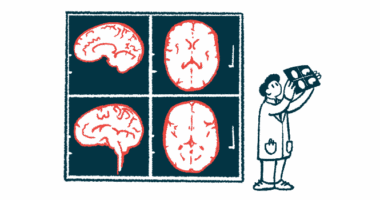CMV infection may contribute to AQP4-linked NMOSD
Molecular similarities may contribute to development of NMOSD, study finds

When the immune system launches an attack to fight off a cytomegalovirus infection, immune cells may accidentally target aquaporin-4 (AQP4), a protein found at the surface of neuron-supporting cells.
That’s the hypothesis suggested by researchers who analyzed the immune cell receptors of people with and without neuromyelitis optica spectrum disorder (NMOSD).
They found that patients had a much higher proportion of receptors against cytomegalovirus (CMV) — a common virus that typically is harmless — and that the viral protein had similarities with AQP4, the main target of NMOSD-driving self-reactive antibodies.
These findings suggest that molecular similarities between the CMV and AQP4 may contribute to the development of the autoimmune disease.
“Viral infection, especially CMV, was found to be a possible pathogenic [disease-causing] trigger of NMOSD,” the researchers wrote; however, they stressed that the high frequency of CMV infection in the general population points to the involvement of other, likely-genetic risk factors.
The study, “Immune Repertoire Profiling Reveals Its Clinical Application Potential and Triggers for Neuromyelitis Optica Spectrum Disorders,” was published in Neurology, Neuroimmunology, and Neuroinflammation.
NMOSD is driven by the immune system attacking healthy parts of the brain and spinal cord. In most patients, this autoimmune, inflammatory attack is associated with the presence of antibodies and immune cells targeting AQP4, a protein present in astrocytes, which are cells that typically provide support to neighboring neurons.
However, the specific mechanism behind the production of anti-AQP4 antibodies remains unclear. In addition, the presence of these self-reactive antibodies alone is insufficient to trigger NMOSD, and increasing evidence suggests that immune T-cells against AQP4 have a key role in the disease’s development.
T-cell receptors’ interactions with antigens
T-cells, a type of immune cell with central roles in fighting off infections and also in autoimmunity, are equipped with a T-cell receptor or TCR on their surface. Each T-cell’s TCR is able to bind to a single molecular target, called an antigen — usually a piece of an infectious virus or bacteria.
When a T-cell’s receptor binds to its antigen, it activates the cell to go on the attack, spewing out pro-inflammatory signaling molecules and growing to make more T-cells with the same receptor.
However, there is limited information on the TCR repertoire of people with NMOSD.
To know more, the team of researchers used advanced sequencing technologies to analyze the TCR makeup of T-cells from the blood of 151 AQP4-associated NMOSD patients and 151 age- and sex-matched healthy people.
Results showed that people with NMOSD had less diverse TCR repertoires than healthy people. Patients tended to have fewer unique TCRs, but a greater proportion of TCRs that were found on multiple T-cells.
Since activated T-cells divide to make more cells with the same receptor, this was broadly indicative of a more immune-activated and inflammatory state among NMOSD patients.
Researchers narrow their focus
From the millions of individual TCRs identified, the researchers zeroed in on 597 that were significantly more common in the NMOSD group.
The team then conducted detailed assessments of 533 of these disease-associated receptors to investigate their potential role in driving NMOSD. The NMOSD-specific TCRs were compared against 533 TCRs selected randomly from the total repertoire in NMOSD patients.
Based on computer simulations, the researchers found that most disease-specific TCRs were predicted to bind to viral antigens, most commonly CMV (66.8%). By comparison, only about 3% of the randomly-selected TCRs were predicted to react with the virus.
The NMOSD-specific TCRs also showed a much stronger ability to bind to AQP4. Intrigued by this finding, the team conducted detailed tests comparing the physical structure of the AQP4 protein and CMV proteins.
From these analyses, the researchers found that a specific AQP4 region had a virtually identical shape to that of a specific part of the CMV. This finding implies that certain CMV-targeting TCRs also may be capable of binding to the AQP4 protein.
Since a T-cell will become activated whenever its receptor binds to a target, these molecular similarities could theoretically explain how CMV infection might trigger NMOSD: T-cells fighting the virus also might start attacking AQP4-positive astrocytes accidentally.
Further experiments showed that isolated T-cells from NMOSD patients were much more likely to react against the CMV, and that there were similarities between anti-AQP4 antibodies and those targeting CMV. These data further support the idea that CMV infection could trigger an autoimmune reaction against AQP4.
However, CMV infection is fairly common, while NMOSD is not, suggesting that while the former may play a role in NMOSD development, it is not enough to cause the disease outright, the team noted.
Findings reinforce previous studies
Consistent with results from previous studies, the researchers also found that the presence of certain genetic variations in HLA genes increases the risk of NMOSD. HLA genes are a group of genes that play critical roles affecting how T-cells and other immune cells are able to bind to their molecular targets.
Collectively these data “suggest that CMV may trigger the production of AQP4-specific autoreactive T cells in patients with specific HLA variants,” the researchers wrote.
“Considering the low prevalence of NMOSD and these additional risk factors together, we speculated that CMV infection may be necessary but not sufficient to trigger NMOSD when present alone,” they added.
The team stressed that, while this study is a step forward in understanding of the disease’s underpinnings, these results alone are not enough to prove any cause-and-effect relationship between CMV infection and NMOSD. More studies are needed to further test and validate this idea, they noted.






